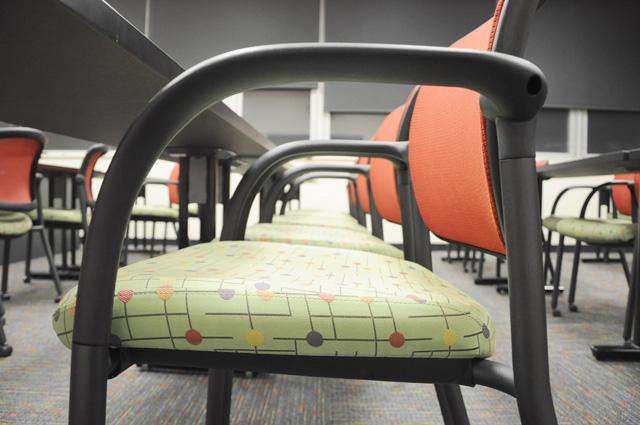Environmental concerns remain important in the development and planning for new construction on campus. After all, encouraging environmentally friendly ways of designing rooms and spaces on campus is a major role of the Sustainability Office.
To meet the University’s sustainability goals, the Office has charged Design and Construction Services Classroom Program Manager Angela Lord, among others, to find ways to become more sustainable.
“When I was a student here, all the classrooms looked identical,” Lord said. “I’ve been trying steadily to change that and put color in the classrooms. Every room that I do is different somehow.”
Design and Construction Services uses several avenues to stay eco-friendly during its planning, Lord said.
“Students are tough, and [they] keep giving me new stuff to dream up,” Lord said.
All the carpet vendors that the department is using have sustainable options to increase the eco-friendly aspects of renovation, including carpet recycling, Lord said.
With recent innovations, the University can install carpets without using glue, Lord said. And all the glues and paints that the University deems as necessary have smaller amounts of volatile organic compounds, chemicals that can evaporate at relatively low temperatures and can be harmful to student and environmental health.
“I’m pretty tough to convince and I do try to break products. I will put products out in classrooms and let them be tried out,” Lord said.
In addition, when buying carpet, Design and Construction Services prefers a certain form of nylon, called 6.6 Antron, which has a tight, strong molecular structure to avoid residual dirt and dust getting trapped in the fibers, Lord said. It only requires hot water to be cleaned.
Many of the fabrics used on are also made to use less water when produced compared to older products. The fabrics have backing to prevent anything from leaking into the furniture.
The department also uses Crypton, which is made in North Carolina. Crypton is the only textile solution offering permanent stain, moisture, mildew, bacteria and odor-resistant protection, Lord said. State also uses a backing product called Nano-Tex, similar to Crypton and also eco-friendly.
One of the newest campus projects is the renovation of the Harrye B. Lyons Design Library. The department is planning to use a carpet called SmartStrand, the first new fiber on the market in a long time that isn’t nylon. This new fiber is corn-based, fade- and stain-resistant. To produce, it requires 30 percent less energy and emits 63 percent less carbon dioxide.
Apart from carpeting, the library will be installing Marmoleum, linoleum-like flooring made with linseed oil. It needs just water to be cleaned. When the renovation is finished in the fall of 2014, the library will be transformed into an innovation lab with design studios.
“How appropriate to put this in the textiles school, which is always looking for new ways to use fibers and fabrics,” Lord said.
The department is always looking for ways to “green” a classroom even more as well. Projects must now meet prerequisites for waste and indoor air quality.
The new projects also aim to divert at least 50 percent of construction or demolition waste from landfills. Lord said the University tries to avoid materials with added urea-formaldehyde.
Some campus buildings, including Sullivan Shops III and the Student Health Center Addition, are “Leadership in Energy and Environmental Design Certified,” a nationwide rating system that ranks green buildings. Certifications in process include James B. Hunt Jr. Library, Gregg Museum of Art and Design, Talley Student Center and Wolf Ridge at Centennial.
“We are trying very hard to find ways to be green. [Many students] don’t know it. We just do it,” Lord said. “What would really be cool is if we could just put signs on everything, but everyone should know that we are doing it.”








